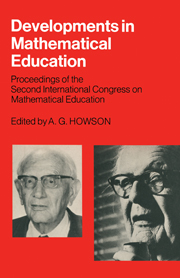 Developments in Mathematical Education
Developments in Mathematical Education Book contents
- Frontmatter
- Contents
- Editor's Acknowledgements
- PART I A CONGRESS SURVEY
- PART II THE INVITED PAPERS
- As I read them
- Comments on mathematical education
- The Presidential Address
- What groups mean in mathematics and what they should mean in mathematical education
- Nature, man and mathematics
- Some anthropological observations on number, time and common-sense
- Mathematical education in developing countries – some problems of teaching and learning
- Some questions of mathematical education in the USSR
- Modern mathematics: does it exist?
- PART III A SELECTION OF CONGRESS PAPERS
- Appendices
- Index
What groups mean in mathematics and what they should mean in mathematical education
from PART II - THE INVITED PAPERS
- Frontmatter
- Contents
- Editor's Acknowledgements
- PART I A CONGRESS SURVEY
- PART II THE INVITED PAPERS
- As I read them
- Comments on mathematical education
- The Presidential Address
- What groups mean in mathematics and what they should mean in mathematical education
- Nature, man and mathematics
- Some anthropological observations on number, time and common-sense
- Mathematical education in developing countries – some problems of teaching and learning
- Some questions of mathematical education in the USSR
- Modern mathematics: does it exist?
- PART III A SELECTION OF CONGRESS PAPERS
- Appendices
- Index
Summary
It would be naïve to bet whether or not you have met figure I before – for many years this has been the first drawing children perform when they are given a pair of compasses. An eight-year-old girl did this.
She was quite skilful at handling a pair of compasses which is a difficult thing for children of this age.
She did even more, she added a second ring of circles as in figure 2. Then I suggested to her that she should colour the drawing, although she would have done so if nobody had mentioned it, because a drawing like this cries out for colours. The most surprising feature of her performance was that it respected flawlessly all the symmetries of the drawing. Of course, the girl would not be able to rationalise her behaviour in a way mathematicians would do, though she firmly grasped all the relevant consequences of such a theory instinctively.
From the decoration of stone age vessels, to the ornamentation of the Alhambra, to Escher's sophisticated graphic art, symmetries have played an important part in painting and sculpture. Science, too, knew and used symmetry as a principle from olden times. Among the few things we know about the first geometer in Greece and the first non-anonymous scientist in human history, Thales of Milete, is that he formulated and used geometrical theorems on symmetry.
- Type
- Chapter
- Information
- Developments in Mathematical EducationProceedings of the Second International Congress on Mathematical Education, pp. 101 - 114Publisher: Cambridge University PressPrint publication year: 1973
- 12
- Cited by
